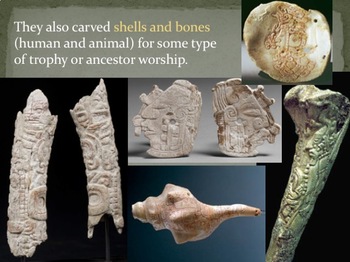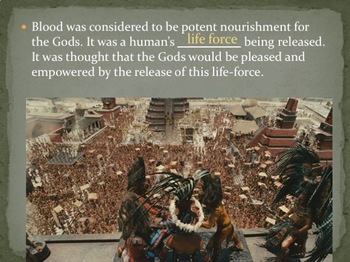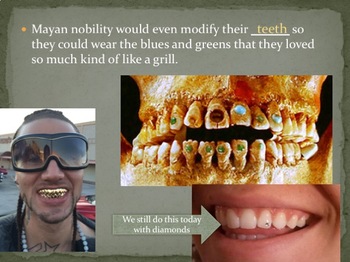Ancient Mayan Art/Culture Lesson Powerpoint
- PPTX
Also included in
- Included in this bundle are the Powerpoint presentation, lesson plan for the lesson/assessments/and project; the grading rubric for the project; the reading material to learn about the Maya; the reading review worksheet to assess if they absorbed the info from the reading; the scaffolded notes thatPrice $10.00Original Price $12.50Save $2.50
Description
This powerpoint goes along with the Mayan Art Lesson Papers that I also have for sale in my store. It gives a general outlook of what the Mayan culture/art/religion/etc. were all about. I talk about and show examples of things in this order: World review, Mayan overview, culture concept, geography, daily life, the student project, religion, painting, sculpture, in-class pok-a-tok competition, architecture, government, what else is going on in the world, and interesting facts.
The world review recaps some things from our previous lessons and cultures older than the Mayans. The Mayan overview hints at the basics of the culture. The culture concept is a very short description (usually a few words) that I feel represent a culture or time period. This does help students keep their history and their people groups straight. I give a brief overview of the ancient Maya before opening the lesson with a geography section. We talk about the location, climate, and benefits of living in this area.
In the Daily Life section I start out talking about farming habits and foods that were a huge staple in their diets. Next comes trading, fabrics, color and symbols in terms of social status, clothing, hair, and tattoos. Pok-a-tok was an odd extreme sport played played all over the empire. I discuss rules but not much is known about the original structure. I talk about how the Mayan calendar works and show examples of the "gears" that make it move. I end the section discussing Mayan text glyph blocks. Some examples are given and then the student project is introduced so they may start designing and have a break form taking notes.
In the religion section I discuss Gods and the divinity of the ruling elite as well as the basics of Mayan beliefs of the 3 realms (celestial, earth, and underworld). We spend a handful of slide focusing on human sacrifice, its meaning/purpose, as well as its restricted nature. Some examples are given also of overlapping beliefs between Egypt and the Mayans.
In the painting section I liken them to the Egyptians again in their overall form (body language and use of text). Frescoes are explained. Pottery and scribes are discussed. In the Sculpture section I talk about materials, relief, stucco, stele, bones, lack of potter's wheel, and burnishing. I also show their preference for the colors blue and green (oddly enough through piercing ones' teeth).
I give another break from notes and have a class competition at this point playing a game of poker-a-tok with trash cans and a balloon. They must follow the real rules of the game but for each goal that is scored, a player of the other team must take a seat!
In the Architecture section I start with how and why they were using limestone. I I compare commoners huts with the stone palaces of the wealthy. We look at city plans, temples, observatories, and multiple of the best examples of the massive temples throughout the area.
In the Government section I discuss the problems with having an empire made up of city-states, talk about kings and their roles within the hierarchy, government councils, the court system, and a little war and weapons.
The What Else Is Going On In The World section is a time line to show exactly when some of the most famous events, inventions, and people overlapped as each ancient culture happened around the same time. and then the Interesting Fact section pokes fun at some of the more unexplainable things going on during this time such as temple structures mating from continent to continent and ancient man knowing /using aerodynamics.
For the project mentioned above, I have my students use a website that has a Mayan glyph dictionary to plan out and sketch the glyph blocks needed to say what they are trying to say in their design layout. Obviously some sounds were not used phonetically since Mayan is a specific language but the Mayans also did not have a word for a lot of things that students are going to try to translate. Modern words would have no place in an ancient language so I tell my students if they absolutely MUST then they can create their own glyph or two to fill in the gaps in their translation designs.
Students are always very interested in the Mayan civilization mostly because of the human sacrifice but hopefully they can learn a thing or two about the culture and how this culture was very similar to multiple others from all over the world!






